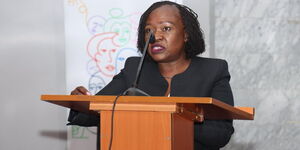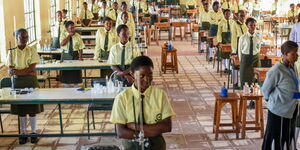Health Acting Director-General Patrick Amoth admitted that the potential loss of millions if not billions of shillings was what informed the Ministry's decision to have school's reopened during the ongoing Covid-19 pandemic
"School is the safest corridor for students to be able to achieve their full potential. Studies done by the World Bank and the IMF indicates that for every year a child is out of school, you lose the equivalent of 4,500 US dollars (Ksh 492,075)," he stated during a press briefing on November 16.
"If you multiply that by the number of students in the country which is 15 million, notwithstanding the parents who also have to stay back at home and take care of the young ones and lose an equal amount of money, the loss is monumental. Suppose the pandemic lasts for 5 years, are we going to close schools for 5 years and have no future," he added.
This did not go down well with a majority of Kenyans who questioned the morality of quoting financial concern as a reason for the reopening of schools which has increased Covid-19 infections and resulted in fatalities in the educational sector.
"What is the cost of one child's life, in dollars?" a Kenyan posed.
"They have already concluded the tradeoff and determined that putting the life of a child at risk is far lower than losing $4500. Our Lord shall be our defender," another added.
The DG's latest statement came on the very day a Form 4 student at Lureko Secondary School in Mumias West reportedly died from Covid-19.
Schools all over the country have been reporting cases of students testing positive for the coronavirus (Covid-19), with the latest incident recorded in Kilifi.
On November 17, Kilifi Governor Amason Kingi revealed that 38 students from Marafa Secondary School have tested positive for the novel virus.
The infected students, Kingi said, have been isolated in the institution.
“We are not got allowing these cases to spread the way it is happening, if people do not follow these rules, we will be forced to impose a cessation of movement to protect our citizens,” the Governor asserted.
The cases in Kilifi are just a fraction of the overall potential crisis in schools following the second wave of the pandemic sweeping across the country.
Kenya has so far recorded 70,804 positive cases with 1,287 fatalities and 46,244 recoveries.
During the month of October when Education CS Magoha announced the partial reopening of schools, the country witnessed the highest number of deaths from the virus.
At least 285 people died during the 31-day period, which translates to 9 deaths per day.
It is such numbers that have parents up in arms following the latest statement from the Health Ministry that came off as equating children to commodities.
However, according to the report that Amoth quoted, The Economic Impacts of Learning Losses published by the World Ban, the overall impact of students remaining at home would have far-reaching consequences in the future.
"Research in the economics of education shows that each additional year of schooling increases life income by an average of 7.5-10%. In other words, a loss of one-third of a school year’s worth of learning would reduce the subsequently earned income of the pupils concerned by about 3%," reads an excerpt from the report.
"Unless schools get better, the current students will be significantly harmed. Moreover, the harm will disproportionately fall on disadvantaged students," it further reads.
On his part, Health CS Mutahi Kagwe issued a new directive regarding any school that recorded Covid-19 cases.












